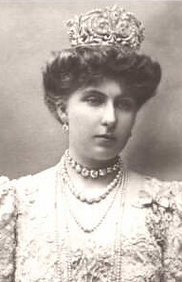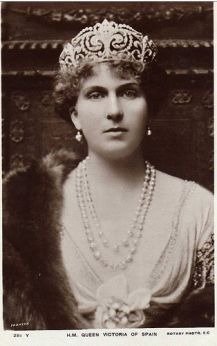Royal Tiaras of the Extended Family
Jump to navigation
Jump to search
THE FLOWER OF LIS DIAMOND TIARA 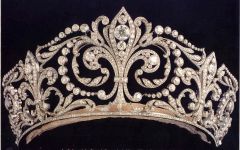 This tiara is said to be one of the most cherished by the Spanish Royal Family. It was a present given by King Alfonso XIII to Queen Victoria Eugenia, who wore it at their wedding on the 31 of May 1906. 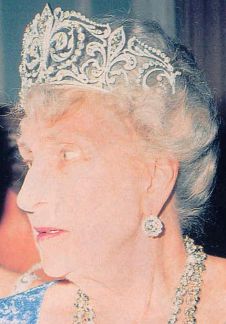 It was designed by the Spanish jewelry house Ansorena. The Fleur-De-Lys Tiara is made of platinum and diamonds forming the Fleur-De-Lys, the heraldic emblem of the House of Bourbon. 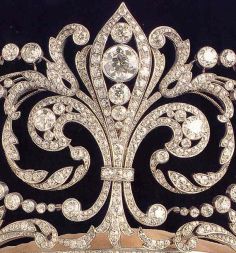 Queen Victoria was born Princess Victoria Eugenie of Battenburg, daughter of Princess Beatrice of the United Kingdom and Prince Henry of Battenburg. |  THE NON-NUPTIAL TIARA OF SPAIN 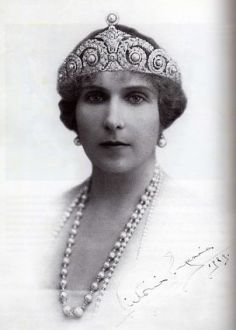 Designed by Cartier, this tiara has 8 big pearls which can be replaced by emeralds. 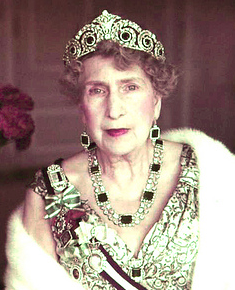 Known as the Pearl Tiara of Queen Ena (Victoria Eugenia) nobody in the Spanish Royal Family has worn it at their own wedding and that is why it is not considered a wedding tiara. 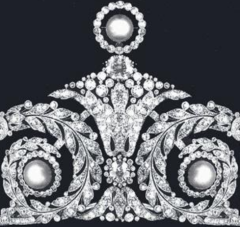 Queen Victoria Eugenia gave it to her daughter Infanta Maria Cristina who offered the tiara to her nephew King Juan Carlos, the current king of Spain. 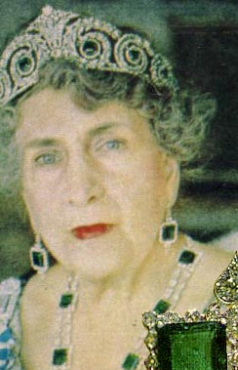 Above Queen Victoria Eugenia of Spain ... a royal, she had taste and a truly regal look. During her exile she always traveled with all her jewels - causing considerable stress to her staff. | CURRENT WEARERS OF THE TIARAS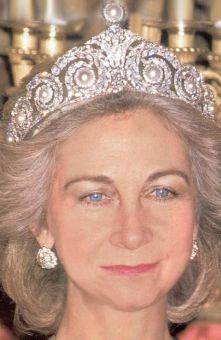 The current Queen Sofia now wears the two tiaras. King Juan Carlos bought the pearl tiara for Queen Sofia in the 1990s, which had been in the possession of his aunt, Infanta Cristina, and the tiara returned back to Spain. As seen in this picture a pearl surrounded by diamonds was added to the top of the 'Non-Nuptial' tiara. The close up of the tiara in the middle column shows the detail. 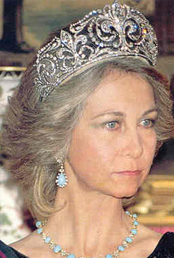 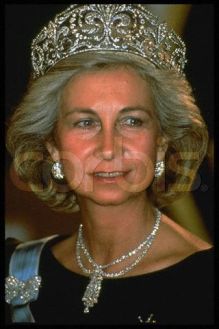 Queen Sophia was herself a descendant of Queen Victoria through both her mother and father by Victoria's daughter Princess Victoria, Princess Royal who later became Empress of Germany. 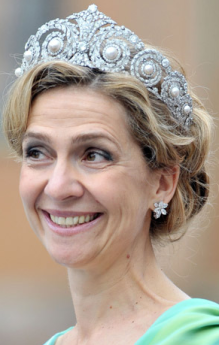 Sophia's daughter, the Infanta Cristina of Spain, was recently seen wearing the tiara to the wedding of Crown Princess Victoria of Sweden in 2010. |
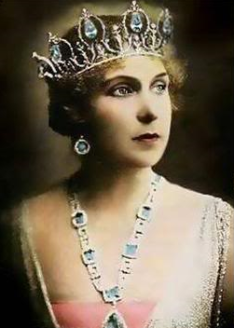 AQUAMARINE TIARA CONT.... Queen Ena is wearing her Brazilian aquamarine parure, consisting of a tiara, necklace and pendant, two sets of earrings, bracelet, and a two-piece pendant brooch. 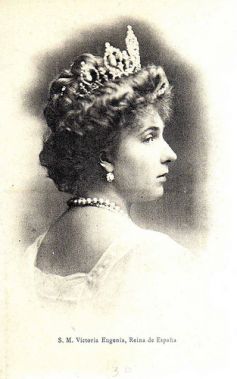 The tiara was created by the court jeweler, Ansorena of Madrid -- the rest of the parure was created by Cartier of Paris. The aquamarine's could be interchanged with pearls. The tiara was similar in design and look to the Connaught diamond tiara of the Crown Princess Margaret of Sweden, nee Princess of the United Kingdom. 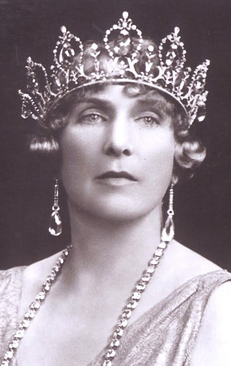 |  AQUAMARINE TIARA OF QUEEN EUGENIE OF SPAIN 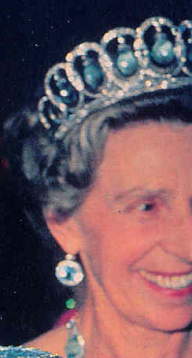 The parure of Queen Eugenie descended to Queen Ena's daughter, the Infanta Beatriz (married to Allesandro Torlonia, fifth prince of Civitelli-Cesi) and from her to her daughters. The parure remains intact to this day, except that the Infanta Beatriz had the tiara redesigned in an interlocking circle pattern with the aquamarine briolettes suspended within each circle. 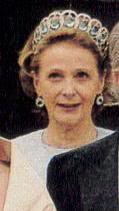 Infanta Beatriz's daughter, Donna Olimpia Torlonia di Civitella-Cesi (now Mrs. Weiller) owns the tiara and matching earrings. 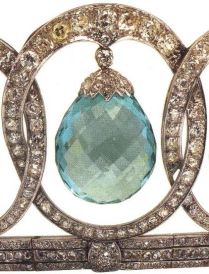 At present, Olimpia Weiller owns the tiara and matching earrings; her sister, Donna Sandra Torlonia, owns the necklace, the brooch and the bracelet. 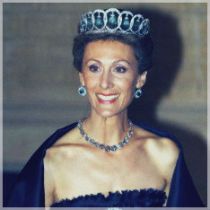 Princess Sibilla of Luxembourg, daughter of Donna Olimpia. She is the wife of Prince Guillaume of Luxembourg, Prince of Nassau and Parma. | 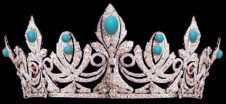 THE CHAUMET DIAMOND TIARA (The above picture is an idea of what the Chaumet tiara would have looked like with its original turquoise stones before Queen Ena had them replaced with diamonds.) 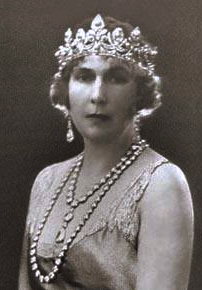 The new Queen was presented with a tiara by Alfonso XII as a wedding gift. The tiara, which was made by Chaumet, was originally set with diamonds and turquoise (which was very fashionable at the time). 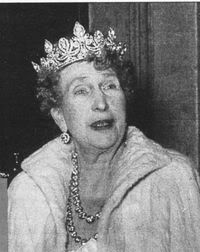 The Chaumet spike tiara in the form of stylized lilies (another homage to the Bourbon fleur de lys) with turquoises mounted in platinum. This was the tiara that Ena wore right before her wedding at a royal performance at Madrid's Teatro Real given in her honor. 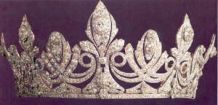 Ena replaced the turquoise with diamond brilliants and wore it on State occasions. She sold the Chaumet tiara, and it was resold in 1984 by Christie's Geneva for eleven million pesetas, or approximately $85,000 US dollars. It was reportedly acquired by an "international jewel collector of royal origin." Nothing more than that is known. |
 CARTIER DIAMOND LOOP TIARA OF QUEEN ENA 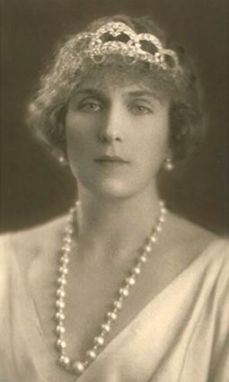 Similarly, the fillet is the rim of the ancient world as a precursor of the diadem. The award of the oak wreath, Augustus deserved for civil services; the successful general was honored with a gold laurel wreath and in 1804 Napoleon crowned himself emperor with a wreath. The wedding jewelry of Princess Marie Bonaparte in 1907 was in the form of a laurel or olive wreath diadem. These wreaths and garlands returned in style regardless of the nature of the diadem, as a garland or decorative element of laurel leaves and an acanthus pattern again and again. In 1927 Queen Victoria Eugenia of Spain ordered a tiara with arching laurel wreaths intertwined around two horizontal garlands of leaves, a thematic invention which, considering the predominant style of art deco at this time, can be explained only by reference to the requirements of traditional court etiquete. Source: Nadelhoffer The description was as follows: two horizontal sheet garlands wrapped in curved laurel wreaths (actually the typical elements of the garland style, but strict and geometric in the execution of the pattern, again this is typical of the Art Deco), the arch top diamonds are the big focus, as in the center of the axis. A thematic invention. Her Majesty wears the tiara in the picture above. It is one of the few pictures, if not the only photo that exists with the diadem. She had this jewel sold apparently during her exile to pay for her living costs, because she received no income from assets left behind in Spain. There is no information on the whereabouts of this piece after her death, but it is not mentioned among the pieces she sold in different moments of ther exile. The actual picture of the tiara above is a later version of the same type of tiara with diamonds in platinum and large brillants, altered, with a free hanging pear-shaped diamond as its center. | 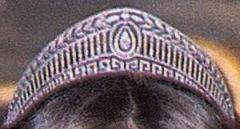 THE PRUSSIAN TIARA 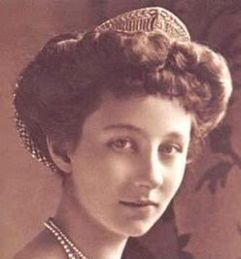 The Prussian Tiara, made of platinum and diamonds with a large, pear-shaped pendant at its centre, dates back to Kaiser Wilhelm II who offered it to his daughter Princess Victoria Louise of Prussia (granddaughter of Queen Victoria), the grandmother of Queen Sofía of Spain, on the occasion of her wedding to Ernest Augustus, Duke of Brunswick in 1913. 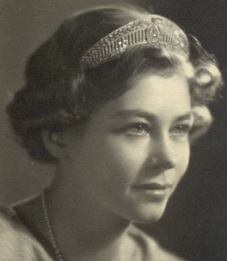 Princess Victoria Louise passed it on to her daughter Princess Frederica of Hanover. 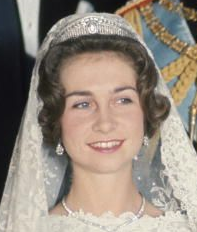 In turn Frederica offered the Prussian Tiara to her daughter Princess Sofía of Greece and Denmark (later Queen Sofia of Spain), who wore it on the occasion of her wedding to Don Juan Carlos in 1962. 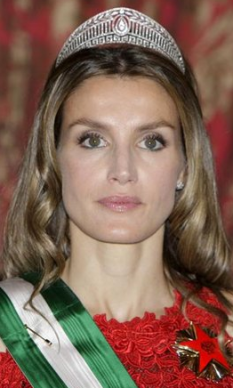 The Prussian Tiara was also worn by Doña Letizia on the occasion of her wedding to Prince Felipe in 2004. | TURQUOISE STAR TIARA OF QUEEN ENA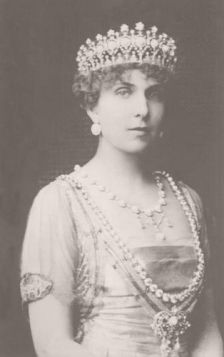 The Turquoise Star tiara appears to have turquoise inserts with small star caps. Queen Ena's jewelry is fairly well known and documented, and this particular one has seemed to escape documentation. A magazine at the time of the wedding mentioned that King Edward VII of the Untied Kingdom and Queen consort Alexandra gave Ena a turquoise and diamond parure as a wedding gift, so the tiara could be part of that parure - it is definitely known that Edward VII gave Ena the necklace she is wearing in this photo. It is for certain that King Alfonso did not give Ena this tiara -- during their engagement, he presented Ena with a Chaumet turquoise and diamond platinum tiara (seen above) which means she had two turquoise tiaras (until she replaced the turquoise stones in the Chaumet tiara with diamonds). 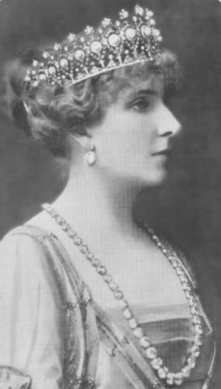 Its current whereabouts are unknown; it is entirely possible it was broken up to make a new tiara or may have been privately sold. This is a fairly clear photo of the tiara, as well as the matching turquoise necklace and earrings. What happened to these pieces is unknown as well. Contrast this fact with the fate of the Chaumet tiara -- Ena sold the Chaumet tiara, but for this tiara there are no such records regarding the Turquoise Star Tiara. |
CARTIER HEART TIARA OF QUEEN ENA OF SPAIN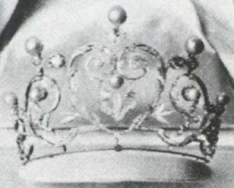 A wedding gift to Ena from her mother in law, Queen Maria Cristina, this set by Ansorena of Madrid consists of a heart motif tiara made of trailing diamond vines with pearl button caps, and a necklace. The tiara came with a pearl necklace. Ena wore the necklace on her wedding day; there are no known pictures of Ena wearing the tiara. The whereabouts of both pieces is unknown. It is possible that Ena had the tiara reworked as the pearls correspond to the pearls in her Cartier mobe pearl tiara. | THE DIAMOND BANDEAU OF QUEEN ENA OF SPAIN 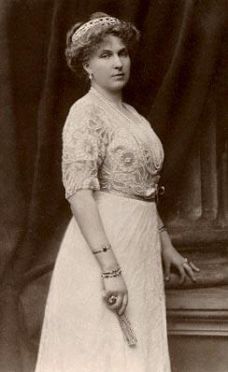 This photo was taken a month after the birth of Ena's third son and eventual heir to the throne, Juan, Count of Barcelona. Not much is known of the diamond bandeau she wears. It is possible that this tiara formed the base for the emerald bandeau tiara seen in the portrait. | MASRIERA TIARA OF QUEEN ENA OF SPAIN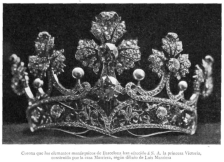 The lost tiara "tiara desaparecido" is actually a circlet. This was a wedding gift to Queen Ena from the people of Catalonia. Made by the world famous art nouveau master jewelers Masriera of Barcelona, the photo does not reveal the Masriera touches that differentiate this tiara from most other gothic fleuron tiaras. The tiara was made of diamonds and pearls in a gold frame with multi-color translucent enameling (plique-a-jour) in what appears to be a "Mary Stuart" or "widow's peak" frame. Given the soaring prices that early XX Century Masriera brooches bring at Christies or Sotheby's lately, one can imagine the value of this piece today if it still exists. |
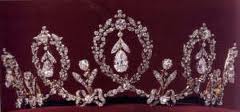 CONNAUGHT TIARA OF SWEDEN 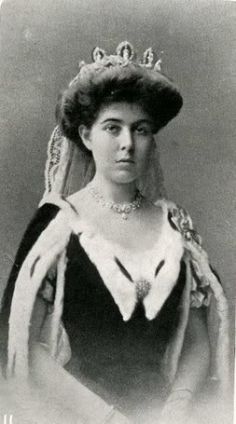 This tiara was brought into Sweden by Princess Margaret of Connaught when she married the future King Gustav Adolf in 1905. It was a wedding present from her parents Prince Arthur, Duke of Connaught and Strathearn (7th child of Queen Victoria and Prince Albert) and Princess Louise Margaret of Prussia. It's a diamond-set tiara in the form of loops of forget-me-not flowers secured by bows, from which hang diamond drops. It was made by E. Wolff & Co. and probably supplied by Garrard. The tiara consists of five 5 looping swags of forget-me-not flowers and leaves, each with a detachable hanging pendant, all of which are separated by upright diamond springs on wire springs. 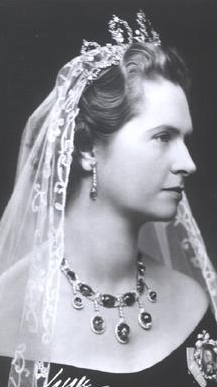 The tiara was eventually given to her eldest son Edmund who gave it to his bride Princess Sybilla of Saxe-Coburg-Gotha, a great-granddaughter of Queen Victoria by her son Prince Leopold, Duke of Albany, as a wedding gift. 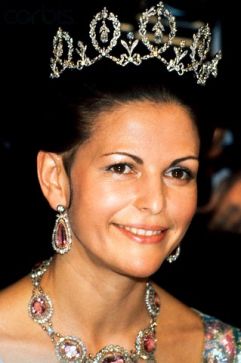 Sybilla gave it to her son, King Carl Gustav. His wife, Queen Sylvia, wears it frequently. 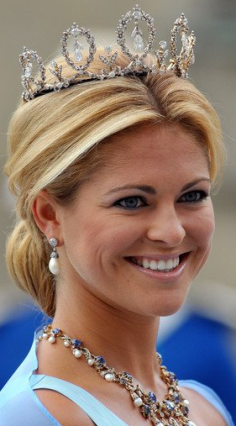 Princess Madeleine, younger sister of Crown Princess Victoria, was seen wearing the tiara to her sister's wedding in 2010. 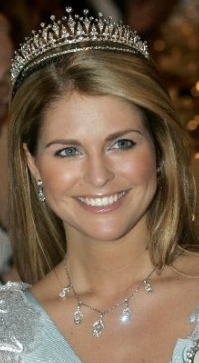 The diamond drops can be taken off and worn as a necklace as seen on Princess Madeleine. | THE GRAND DUCHESS VLADIMIR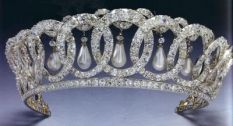 The Vladimir Tiara, Russia, c.1890 This was the original setting of the "Vladimir Tiara" at the time of its purchase in 1921, by Queen Mary. 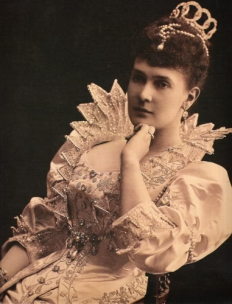 The first version of the tiara.. (above) 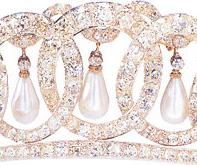 Made for Grand Duchess Vladimir, aunt by marriage of the last Russian Tsar Nicholas II. She was born Marie of Mecklenburg-Schwerin. Grand Duchess Maria Vladimir Alexandrovich got jewelers and artisans working for the Russian court to design and execute this exquisitely crafted tiara in the year 1890. 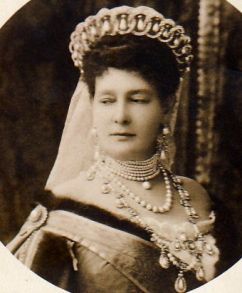 The Grand Duchess Vladimir Tiara was designed and executed in the tradition of the late 19th century, and consisted of a combination of diamonds and pearls. The Grand Duchess escaped from Russia during the 1917 Russian Revolution but left her renowned collection of jewelry including the Vladimir Tiara, hidden in a vault in the Vladimir Palace in St. Petersburg, at the time of her escape. 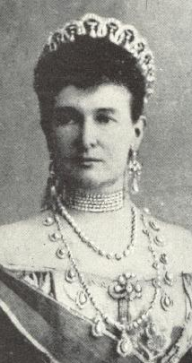 The tiara designed by an unknown Russian jewelry craftsman, consists of fifteen interlaced thick metal circles. At the bottom, the overlapping circles are attached to a semi-circular thick band of metal, that forms the circlet of the tiara. At the top the overlapping circles are held together by a wavy snake-like band that intertwines the circles passing in and out of them. The thick circles as well as the upper and lower bands are closely laden with round brilliant-cut diamonds, that impart the brilliant sparkle so characteristic of this tiara. The beauty of the tiara was further enhanced by the swinging oriental pearl drops or pendants with small diamond set mounts, positioned inside each circle, but hanging from the wavy band and not from the circle. 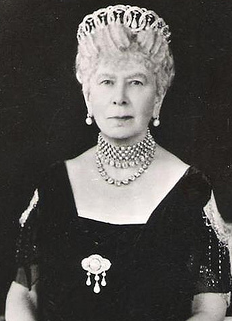 The tiara was smuggled out of Russia during the Revolution by a British diplomat. In 1921 it was sold by the Grand Duchess’s daughter, Princess Nicholas of Greece, nee the Grand Duchess Elena Vladimirovna of Russia (mother of Princess Marina, Duchess of Kent) to Queen consort Mary of the United Kingdom. It was Queen Mary who adapted the tiara to take fifteen of the celebrated Cambridge emeralds as an alternative to the original pearls. The tiara was inherited by The Queen from her grandmother Queen Mary in 1953. The Cambridge version is on the original More British Royal Tiaras page. | THE KHEDIVE OF EGYPT CARTIER TIARA OF SWEDEN 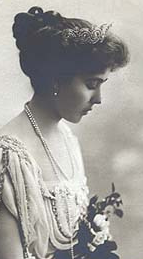 A jewel of great sentimental value to the Danish Royal Family is the diamond and platinum Cartier tiara of Crown Princess Margarita of Sweden, nee Princess Margaret of Connaught and the United Kingdom. It was originally a wedding gift from the Khedive of Egypt to Princess Margaret of Connaught, who was to marry the future King Gustav VI Adolf of Sweden in 1905. Egypt was the place where the royal couple first met. 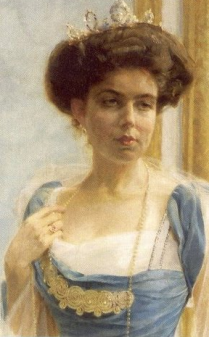 Princess Margaret also wore the tiara as a corsage as seen in the painting. 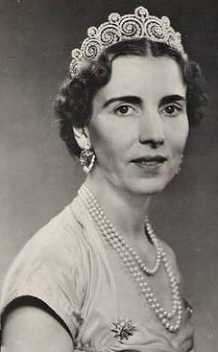 After the untimely death of Crown Princess Margarita in 1920, the tiara was inherited by her daughter Princess Ingrid, who brought it with her when she married into the Danish Royal Family in 1935. 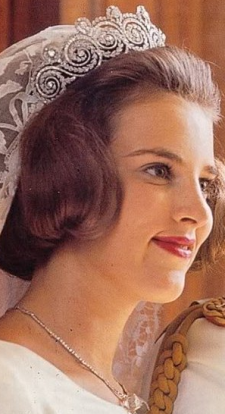 Upon her death in 2000 the tiara passed on to Queen Ingrid's youngest daughter, Queen Anne-Marie of Greece, nee Princess of Denmark (above). When the three daughters of Queen Ingrid got married, they wore their grandmother's tiara as a way to acknowledge her memory; 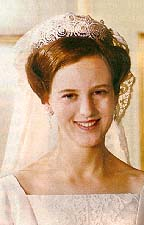 Princess Margrethe in 1967, Princess Benedikte in 1968 and Princess Anne-Marie in 1964. 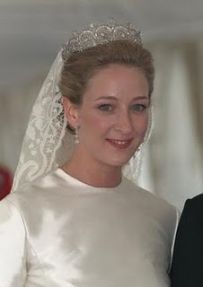 This lovely family tradition was carried out in the next generation, with Princess Benedikte's older daughter Princess Alexandra zu Sayn-Wittgenstein-Berleburg wearing the tiara in 1998, and Queen Anne-Marie of Greece's Alexia wearing it in 1999. |
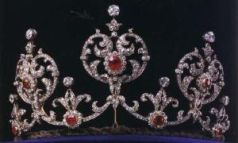 RUBY AND DIAMOND TIARA FROM HM KING EDWARD VII 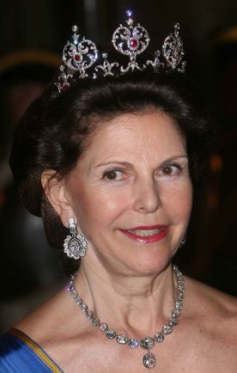 The tiara gets its name from the person who gifted it to Princess Margaret of Connaught — her uncle, King Edward VII of Great Britain — when she married Crown Prince Gustaf Adolf of Sweden in 1905 at Windsor Castle. 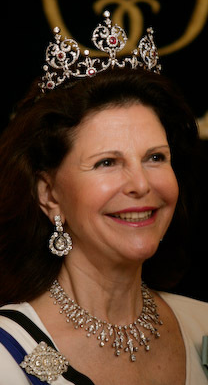 Margaret died before she could become Queen of Sweden, but in one of the weird twists of royal genealogy, Gustaf Adolf married Lady Louise Mountbatten as his second wife. Margaret and Louise were cousins, both having descended from Queen Victoria, so Louise and her new step-children were also cousins. The pictures above feature the current Queen of Sweden wearing the tiara. 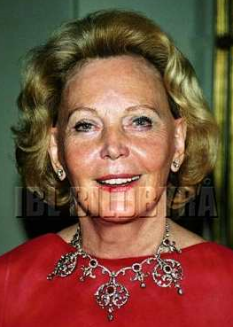 The Edward VII Ruby Tiara can also be worn as a necklace, as seen here on Marianne Lindberg. 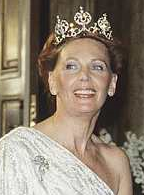 Marianne was the wife of Prince Sigvard of Sweden who died in 2002, he was also uncle to the current king of Sweden. It is believed that this tiara was in the possession of Prince Sigvard who was the son of Princess Margaret of Connaught, who originally received the tiara. It is debatable as Queen Silvia now wears the tiara. | 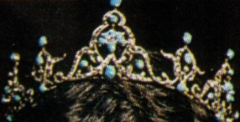 QUEEN MAUD OF NORWAY'S TURQUOISE TIARA 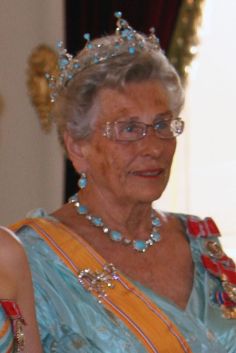 This is one of the tiaras that HH Princess Astrid now herself owns. The tiara, first owned by Astrid’s grandmother, Queen Maud, nee Princess of the United Kingdom, was apparently a wedding present to Maud when she married Prince Carl of Denmark (who later became King Haakon VII of Norway). Princess Astrid is the second daughter of King Olav V of Norway and his wife, Princess Märtha of Sweden. 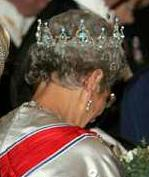 This tiara, unlike others, encircles the entire head. With that said it could be argued that it is a crown, but none the less it is known as Queen Maud's turquoise tiara. 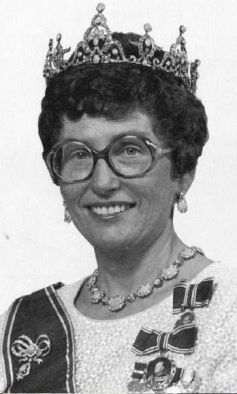 Hopefully the tiara will be given to the royal family of Norway and not passed on to Princess Astrid's descendants as the tiara is originally from HM Queen Maud. 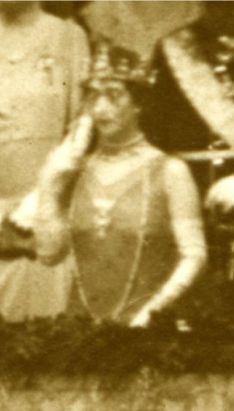 | 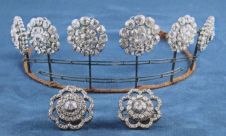 THE FOUR AND SIX BUTTON TIARA OF SWEDEN 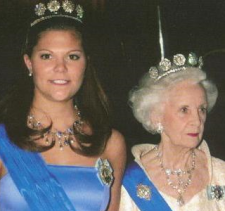 The buttons of the two different tiaras, 4 button and 6 button are not identical. 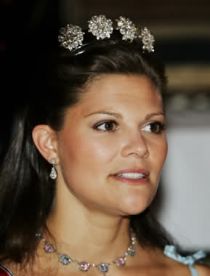 The ones from the four-button-tiara look more like sunburst or star-design, while the ones from the six-button-tiara really look like flowers with small leaves. 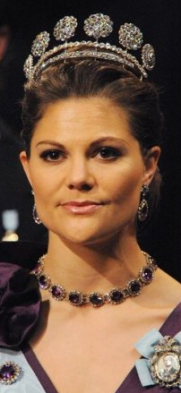 It was said that the buttons were the property of Carl XIV Johan. They are supposed to be a part of his gala uniform, perhaps from his days as french marshall. After that he had them placed on the king´s crown for his coronation 1818, they were later removed and made into tiaras. But, it could be older items and also the usage of Marshall Bernadotte, earlier or the famous and amazing stomacher, breast decoration, or hair jewels of the Queen Luisa-Ulrika and her mother, Sophia Dorothea. 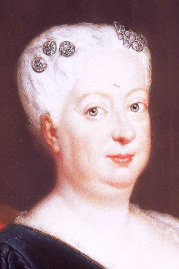 Sophia was the only daughter of George Louis of Brunswick-Lüneburg, later King George I of Great Britain, and Sophia Dorothea of Celle. Sophia of Hanover married King Frederick William I of Prussia. 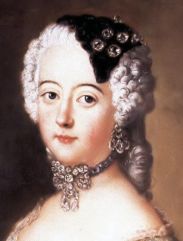 Her daughter Louisa Ulrika married King Adolf Frederick of Sweden. |
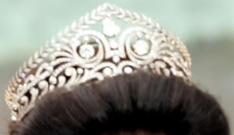 BRUNSWICK DIAMOND TIARA 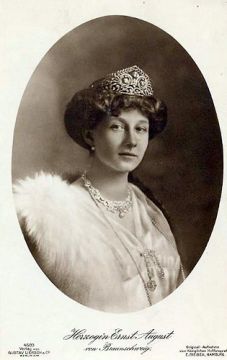 A diadem which had received the Duchess to the wedding 1913 as gift of the duchy Braunschweig. Princess Viktoria Louise of Prussia, great-granddaughter of Queen Victoria married Ernest Augustus, Duke of Cumberland, son of Queen Alexandra's sister, Princess Thyra of Denmark on 24 May 1913. Ernest's great-grandfather, Prince Ernest Augustus, Duke of Cumberland, the fifth son of George III of the United Kingdom, became king of Hanover in 1837 because Salic Law barred Queen Victoria from reigning in Germany. Their wedding was one of the last great social events of European royalty before World War I. It was celebrated in the presence of George V of the United Kingdom and Tsar Nicholas II of Russia, as well as other important royals. There was few time until the wedding and it seemed impossible to make a new tiara, so they had to look out for one which had already been manufactured. Fortunately, the Saxon Court Jeweller, Moritz Ellimeyer, in Dresden had such a jewel. Hartwieg made the jeweller to present it to him. The correspondence between him and Jeweller Ellimeyer about the purchase 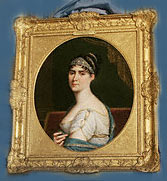 is kept in the national archives. They contain important details on the origins of the tiara, which Hartwieg wanted to be informed of. is kept in the national archives. They contain important details on the origins of the tiara, which Hartwieg wanted to be informed of. The tiara originates from the imperial jewels of the Bonaparte family and was worn of the Empress Josephine Beauharnais. There is a painting of the Empress where the tiara can be identified. The bill of costs with details, is also kept in the national archives. There were two major diamonds missing from the tiara which were replaced by the Court Jeweller of Brunswick, Jürgens, who was able to procure the missing diamonds immediately. Hartwieg planned to make a jeweller from Brunswick refurbish the tiara. According to the newspaper, the bride and the groom were visibly moved and warmly pleased. This also showed their returning thanks, which the Empress, too, expressed. The gift met with everybody’s approve. The lord ships could not find enough words to express their delight and appreciation… The young bride wore the tiara of Brunswick already at the family lunch that day and occasionally at Gala operas. | BRUNSWICK DIAMOND TIARA CONT...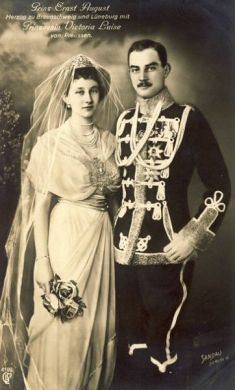 After the death of his father in 1953 the late Prince Ernst August, Head of the House Hanover (son of Princess Victoria Louise and Ernest Augustus), required the Diadem of his mother, for his wife Ortrud. The Duchess however kept the Diadem, her favourite item, which carried her still gladly on the celebrations of the family, as her personal property. After her death, the executor opened the vault in the North German Landesbank in Braunschweig, which the Duchess had rented, the subject was empty, the tiara rated on 10 million DM at that time, was missing. 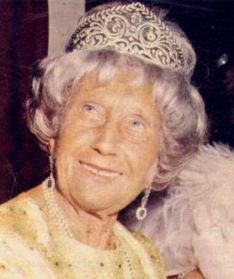 Prince Christian, the younger brother of Prince Ernst August got three boxes with jewels from the properties of his mother Viktoria Louise, which was probably in the bank safe-deposit, he sold gradually this family jewels, which some was auctioned 2 days after he suddenly overtaken by death in 1981. The Diadem however was still disappeared. Neither Princess Ortrud nor Princess Monika, the 2nd wife of the late chief of the guelphs, as well as Princess Chantal, the first wife of E.A, carried the Diadem. 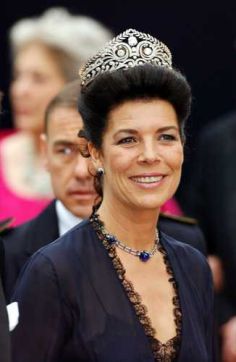 Therefore it was a large surprise, when Princess Caroline of Hanover (nee Princess of Monaco), after her wedding with Prince Ernst August, first lady of the house, wore it in 2004, on the occasion of the wedding of the Crown Prince in Denmark. The wonderful Diadem again in the possession of the family, we don´t know what was happend in this 23 years, was it sold, was it stolen, was it hidden. |  The tiara itself is Queen Josephine’s Diamond Tiara. The Queen Josephine in question is Josephine of Sweden and Norway, who was herself a granddaughter of Empress Josephine, wife of Napoléon Bonaparte. Josephine was the wife of King Oscar I of Sweden and Norway, and was Queen Consort from 1844 to 1859. 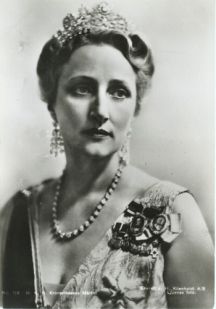 Josephine’s granddaughter, Princess Louise of Sweden (later Queen Louise of Denmark), inherited the tiara. She and her daughters wore the tiara at various times — Princess Thyra of Denmark (sister of Queen consort Alexandra of King Edward VII), for example, was photographed wearing it at the wedding ball for her brother, Crown Prince Frederik of Denmark, in 1935. Queen Louise’s other daughter, Princess Dagmar of Denmark (later Tsarina Maria Feodorovna), inherited the tiara, and then gave it to her niece, Princess Märtha of Sweden. Through Märtha, the tiara came back to Norway, as she had married Crown Prince Olav of Norway in 1929. Märtha was the mother of the current king of Norway, Harald. 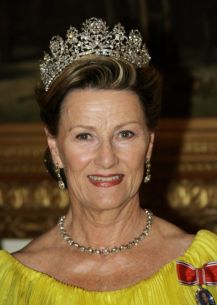 Crown Princess Märtha and later Princess Astrid and Queen Sonja wore it together with diamond rivéres and two large diamond earrings which came from Queen Maud (Princess Maud of Wales, Princess of the United Kingdom). 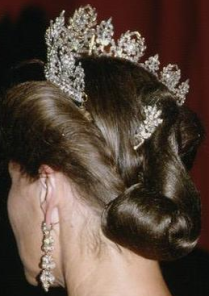 The tiara is now worn regularly by the present queen consort Sonja of Norway. |
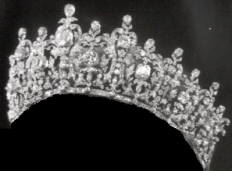 DIAMOND TIARA OF QUEEN SOPHIA OF GREECE 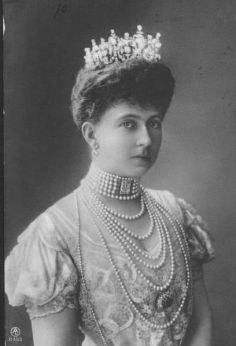 Princess Sophia of Prussia Queen consort of Greece was a granddaughter of Queen Victoria, daughter of Victoria and Albert's oldest girl and child, Princess Victoria, Princess Royal (later German Empress). Sophia married her cousin, Constantine, King of Greece and became Queen consort of the Hellenes (now called Greece). The tiara is said to be a wedding present to Sophia from her mother, the Empress consort Victoria of Germany (nee Princess of the United Kingdom). The tiara, like the Spanish diamond 'Flower of Lis' tiara, can either sit on the head (like above) or wrap around as seen below. 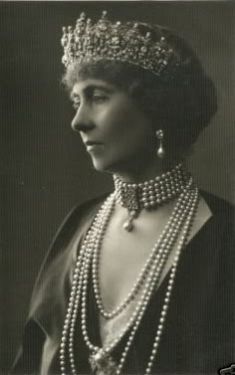 This diamond tiara — Queen Sophia’s Diamond Tiara — was brought to Greece by Frederica’s mother-in-law, who was born Princess Sophia of Prussia. Frederica's grandfather was the brother of Princess Sophia. When Sophie married the future King Constantine I of Greece in 1889, she was given this tiara by her mother, Empress Frederick of Prussia (who is probably more familiar to royal history buffs asPrincess Vicky– the eldest child of Queen Victoria and Prince Albert). The tiarawas a truly impressive diamond sparkler, but alas: most believe that, strapped for cash, Frederica sold it at auction in the ’70s. 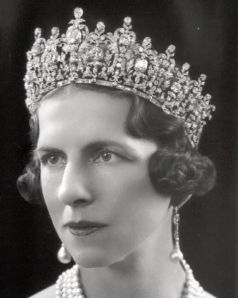 Pictured here, above, is Princess Sophia's daughter, Queen Helen of Romania, nee Princess of Greece and Denmark. Helen did not inherit the tiara, it was passed on to the next King and Queen of Greece. 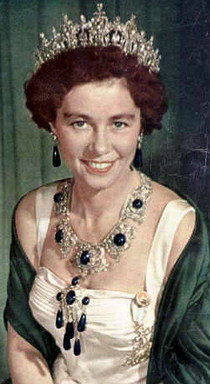 It was last seen worn by Queen Frederica of Greece [who died 30 years ago]. 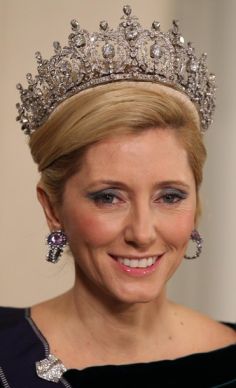 The tiara, which some thought had been sold, turned up in January 2012 at the Gala for Queen Margarethe of Denmark on Crown Princess Marie-Chantal, wife of Crown Prince Pavlos of Greece. | 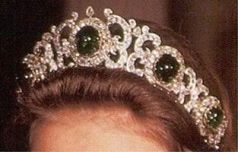 GRAND DUCHESS, QUEEN OLGA'S EMERALDS 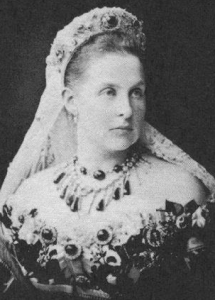 It was Grand Duchess Olga Constantinovna of Russia who brought these large diamond tiara set with five cabachon emeralds to Greece when she married King George I of Greece. Russia was a source of emeralds and the Romanovs had many of the best gems in their possession. 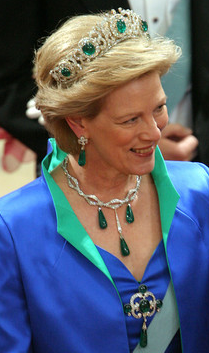 The emeralds were never worn by Queen Sophie, nee Princess of Prussia, because when Queen Olga died in 1926, her son King Constantine I, had himself already died, so the emeralds went directly to his eldest son, King George II. The first person to wear the emeralds after Olga was Queen Sophia's cousin, Queen Elisabeth, nee Princess of Romania, daughter of Marie of Edinburgh, Princess of the United Kingdom, later Queen of Romania. 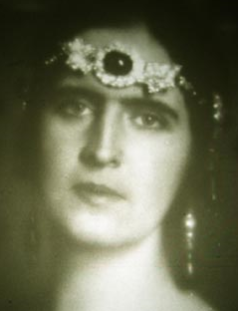 Queen Elisabeth later wore the jewels, as a headband with a central emerald and floral ornaments and as very long earrings in the art deco style. 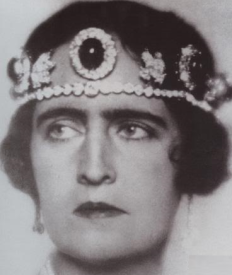 The next illustration shows the addition of further oval cabochons and floral ornaments rising from a base of round diamonds. 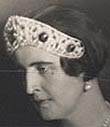 After a further change, one can recognize the final form, as a kokoshnik frame composed of interlaced "E" for Elisabeth in diamond, and the large cabochons between them. Elisabeth and George II had no children, thus the emeralds were passed to the next King, Paul, who married his first cousin, once removed, Princess Frederica of Hanover. Frederica was the great-granddaughter of the Princess Royal, Victoria of the United Kingdom 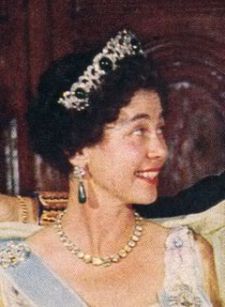 When Queen Frederica wore the tiara, the border had been removed and the jewel augmented. The queen often wore it as a necklace (seen left), along with the diamond tiara of her mother-in-law, Queen Sophia, nee Princess of Prussia. 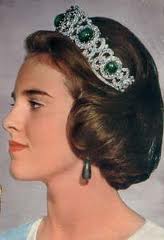 The next and current wearer is the present queen, Anne-Marie, nee Princess of Denmark. |  GREEK KEY TIARA OF ROMANIA 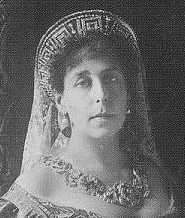 This tiara was once owned by Princess Victoria of the United Kingdom and Saxe-Coburg and Gotha who married first Enerst von Hessen, the Grand Duke of Hesse and second the Grand Duke Kirill of Russia. It was the Grand Duke of Russia who gave her this meander tiara of diamonds and platinum. After the collapse of the Imperial Russian Empire, her jewels were the only property of hers, so Victoria sold her jewelry little by little to survive with her family, as well as the tiara. 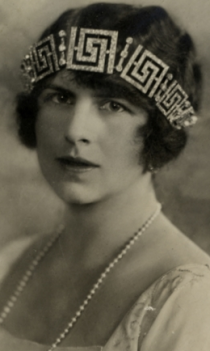 Her sister, the Queen Marie of Romania, nee Princess Marie of the United Kingdom, supported them with jewelry purchases and bought the tiara from them to give it to her future daughter-in-law, Princess Helen of Greece, granddaughter of Princess Royal, Victoria of the United Kingdom. Princess Helen married Crown Prince Carol of Romania in 1921. 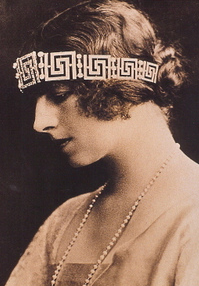 After the death of King Ferdinand, Helen and Carol's five year old son was proclaimed as King Michael I of Romania. Because of his father's lifestyle, the Crown Prince Carol decided to abdicated in 1926 in favor of his son Michael. Carol had chosen to divorce his wife Helen in order to be with his mistress, Madame Lupescu. 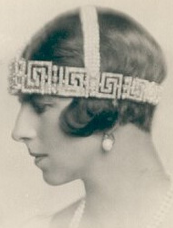 Many important jewels were sold over the years due to the Russian revolution, but this tiara was in possession of the family and was passed down within the Romanian royal family to the next Queen, Anne of Romania, nee Princess Anne of Bourbon-Parma. Queen Anne wore the tiara also on her wedding day to Michael I. 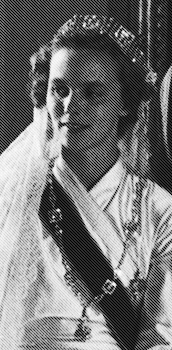 As a member of the Royal House of Bourbon-Parma, she was in London during the wedding of Princess Elizabeth (HM Queen Elizabeth II) and Prince Philip. It was there that she met the young King Michael I of Romania. 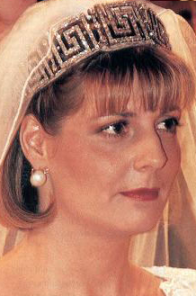 Their daughters, the Princesses Marie and Margarita now use the showpiece of the family. 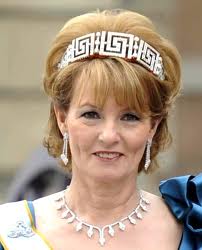 |
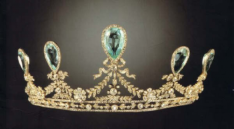 HESSEN RUSSIAN AQUAMARINE TIARA This extremely attractive tiara was part of a parure which has a highly important and interesting historical provenance, as the family states that these jewels had once belonged to the Grand Duchess Elizabeth Feodorovna of Russia (1864-1918). Grand Duchess Elisabeth was born Her Grand Ducal Highness Princess Elisabeth Alexandra Louise Alice of Hesse and by Rhine. Her mother was the daughter of Queen Victoria, Princess Alice of the United Kingdom. 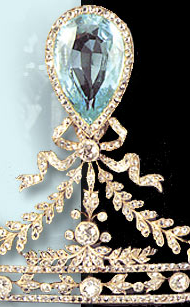 Elizabeth married Sergei Alexandrovitch, Grand Duke of Russia and son of Alexander II, Emperor of Russia. Her younger sister Alexandra was to become the wife of Tsar Nicholas II in 1894, a marriage which the Grand Duchess greatly encouraged. The Grand Duchess was a stunning beauty and her husband showered her with jewels. The Grand Duchess was a stunning beauty and her husband showered her with jewels. They resided at the magnificent Belosseilsky Belosievksy Palace in St. Petersburg which was purchased for them by the Crown in 1884, and when she entertained, it was said: she would go upstais in the middle of the ball to change into a new dress, even more beautiful than the last and an even richer set of jewels. According to an ancient tradition, the aquamarine effect a happy marriage and make its wearer rich - this is meant not only emotionally. Her husband, Grand Duke Sergius was assassinated, their marriage remained childless, but was one of the most beautiful women of her time and her niece, described her look "like angels" and was fascinated by the color of a eissig shimmering traditional court dress of the Grand Duchess, which she at Aquamarine remembered ..... maybe she wore with this jewel set. It is not known by whom the Grand Duchess received this set has, it could be, but a gift from her family, the Hessian Grand Dukes or directly from her brother. For it was this aquamarine set to her brother after she decided to enter the convent and dividing their jewelry. A tiara-style Bändelbögen garlands and bows with ribbons, the lines and edges in diamond mille grain fully set with diamond-Rosen, Kissenfömige diamonds decorate the loop points, decorated with five pear-shaped blue aquamarines are beautiful. The aquamarines are placed upright, and each provided with a diamond edge. | IMPERIAL SAPPHIRE PARURE OF THE DUCHESS OF SAXE-COBURG-GOTHA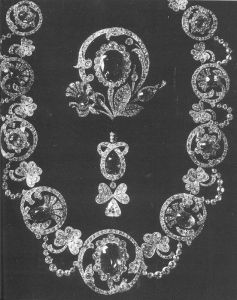 Victoria Melita Feodorovna, Princess of Saxe-Coburg-Gotha & Princess of the United Kingdom became Grand Duchess of Russia upon her second marriage to Grand Duke Cyril Vladimirovich of Russia. Her husband presented her some outstanding jewels, but this magnificent sapphire and diamond parure with elements of the "Thistle of Scotland", the "Rose of England" and the "Irish Shamrock", as diamond stylised three leaf trefoils, was a heirloom of her mother-in-law, the Grand Duchess Maria Alexandrovna of Russia, the Duchess of Saxe-Coburg. 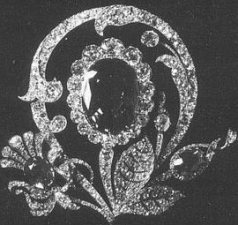 Grand Duchess Maria received this parure (tiara, necklace, large stomacher), with the symbolic ornaments of the United Kingdom, from her father, Tsar Alexander II on the occasion of her wedding to the son of Queen Victoria, the Duke of Edinburgh. As the wife of Grand Duke Cyril, eldest son of Grand Duchess Vladimir, Victoria Melita's fortune was limited to her jewelry after fleeing Russia. After the Russian Revolution, she sold the necklace with the two part stomacher (featured in photo), which had a large triangle diamond as a pendant to the clover, to Cartier, Paris. The current whereabouts of these items is unknown. 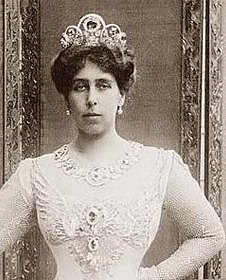 | TIARA OF THE DUCHESS OF SAXE-COBURG-GOTHA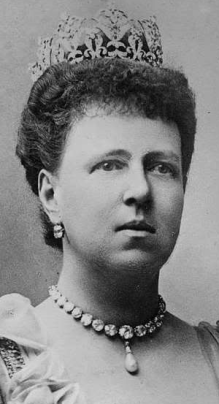 COBURG DIAMOND TIARA THE Grand Duchess Marie Alexandrovna, Duchess consort of Saxe-Coburg-Gotha She was the only daughter of Tsar Alexander II and Maria Alexandrovna, Princess of Hesse-Darmstadt and received spectacular parures upon the occasion of her wedding to Prince Alfred, Duke of Edinburgh (second son of Queen Victoria and Prince Albert); the two most important ones were set with rubies and sapphires. Perhaps she received elements of the jewellery shown here for her wedding as well. The Duchess of Saxe-Coburg-Gotha is wearing a large diamond tiara, probably made by Boucheron, Paris. The upright elements of the tiara are set with several old-mine and rose-cut diamonds. Each top of the v-shaped ornaments is accentuated with a larger diamond. This historical photograph is showing the Duchess also wearing a large diamond rivière necklace with a detachable pear-shaped pearl drop together with a pair of single diamond earrings and a cluster pearl brooch with a large pear shaped pearl pendant. 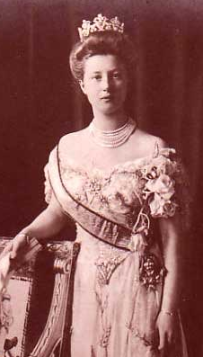 Victoria Adelheid the succeeding Duchess of Coburg, wore the Coburg Diamond Tiara. Duchess Viktoria Adelheid of Saxe Coburg Gotha, née Princess of Schleswig-Holstein (1885-1970) was the wife of Duke CARL EDUARD of Saxe-Coburg-Gotha, the parents of Princess Sybilla, the mother of the current King of Sweden. |
QUEEN MAUD OF NORWAY'S MALTESER DIAMOND TIARA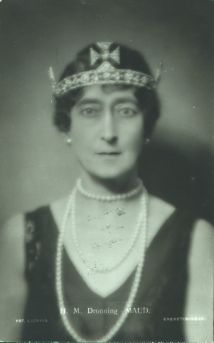 The tiara originally belonged to Maud’s mother, Queen Alexandra, consort of the United Kingdom.  It’s called the “Malteser” tiara because it can be worn with four detachable Maltese Crosses.  The crosses can also be worn as brooches. 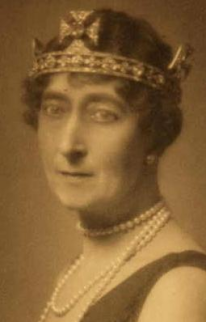 Queen Maud was born Princess Maud of Wales, Princess of the United Kingdom. She was the youngest child of King Edward VII of the United Kingdom and Queen consort Alexandra, nee Princess of Denmark. Princess Maud married her cousin, Prince Carl of Denmark on 22 July 1896. 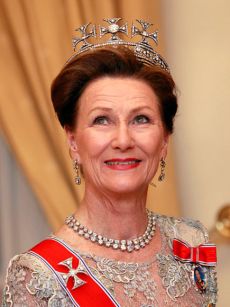 After the political union linking Norway and Sweden was dissolved in 1905, Prince Carl was elected King. Princess Maud became Queen consort of Norway. 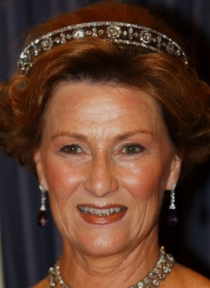 Her wardrobe reflects this sudden change in lifestyle. Not only did Queen Maud need a coronation dress and additional clothes for the events surrounding this important occasion, but for her new role as Queen Consort. 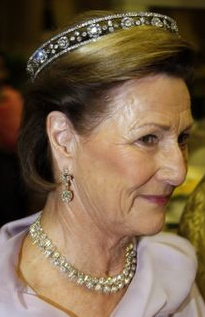 Above, Queen Sonja has chosen just to wear the bandeau base piece of the tiara. | 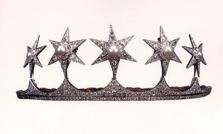 STARS OF PRINCESS ROYAL, VICTORIA 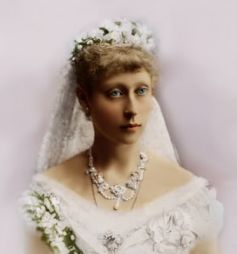 Victoria Alberta Elisabeth Mathilde Marie was born on April 15 1863. She was the first child and daughter of Prince Louis of Hesse and by the Rhine (later Grand Duke Louis IV) and Princess Alice of the United Kingdom, Queen Victoria's second daughter. Victoria married her first cousin once removed Prince Louis of Battenberg on April 30, 1884 at Darmstadt. Queen Victoria attended her granddaughter's wedding. 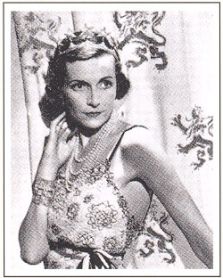 The star tiara pictured above c. 1870, remounted 1937 in England and Gold, silver, diamonds, button pearls.“From the engrailed pavéd diamond circlet rise five five-pointed diamond stars similarly pavéd and centered on a button pearl within a raised border. Made famous by the Empress Elizabeth of Austria, who was painted by F.X. Winterhalter (1865) wearing stars in her hair pinned to a black velvet bandeau, stars sparkling with diamonds have been favoured by women ever since. 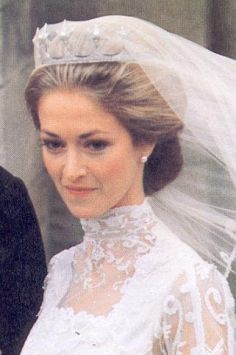 These were given to the daughter of Queen Victoria, Princess Louise, Duchess of Argyll to her god-daughter and niece, Princess Victoria of Hesse, and the Marchioness of Milford Haven, married to the First Sea Lord Prince Louise of Battenberg. As is well known, the revolution of 1917 led to the disappearance of many valuables in Russia, including the Battenberg jewels, which were never seen again. Princess Louise therefore gave Princess Victoria this tiara to replace what had been lost. It then descended to her daughter-in-law, Edwina, future Countess Mountbatten of Burma, who had the stars remounted in a more modern style in the mid-1930s, as seen in the picture above. Edwina was born Edwina Ashley, a descendant of the House of Beaufort and distant 1st cousin of Anne Boleyn. She in turn gave the tiara to her daughter Patricia, the present Countess Mountbatten of Burma, as a wedding present upon her marriage to Lord Brabourne in 1946. She wore it to the court all held at Buckingham Palace to celebrate the marriage of the future Queen Elizabeth II with the duke of Edinburgh in 1947, and it has been worn by her daughters and daughters-in-law at their weddings.” | TURQUOISE BUTTON TIARA OF PRINCESS VIKTORIA OF SAXE-COBURG-GOTHA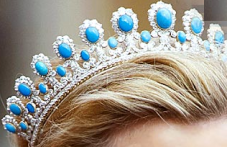 The marriage of Duke Charles Edward of Saxe-Coburg and Gotha with Princess Victoria Adelaide of Schleswig-Holstein-Sonderburg-Glücksburg, was celebrated on 11 Oct 1905 in the presence of the German Emperor and Empress. 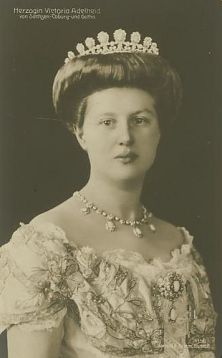 The Duke, who was the only son of the late Duke Prince Leopold of the United Kingdom and Princess Helena of Waldeck, Duchess of Albany, had acceded to the Dukedom of Saxe-Coburg and Gotha in July 1900. Princess Victoria was a great-great-granddaughter of Queen Victoria's mother, Victoria of Saxe-Coburg-Saafeld through her daughter, Princess Feodora of Leiningen, by her first husband, Emich Carl, Prince of Leiningen. 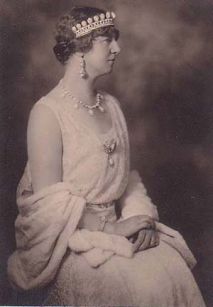 The turquoise and diamond parure consists of a tiara, a matching necklace with five turquoise and diamond oval pendants, a brooch with a large oval stone at the center with a pendant drop and a pair of earrings. The brooch is in the style of the mid-nineteenth century. The origin of the parure has not yet been resolved, because the wedding gift list of Duchess Victoria Adelheid is not yet complete. It could have been the gift of the bride's parents, that of the groom or from a generous relation. 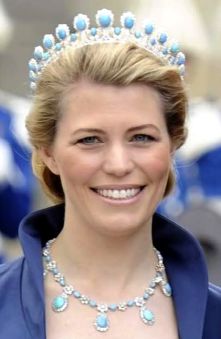 The parure was recently seen on American born Princess Kelly of Saxe-Coburg-Gotha, nee Rondestvedt at the wedding of Crown Princess Victoria of Sweden in 2010. During this occasion the Princess was seen in HH Victoria Adelheid pf Saxe-Coburg-Gotha’s Button Tiara(which hasn’t seen the light of day since Victoria's lifetime.) Princess Kelly was born in San Diego, California, United States. |
DIAMOND LOOP TIARA OF THE GRAND DUCHESS OF SAXE-COBURG-GOTHA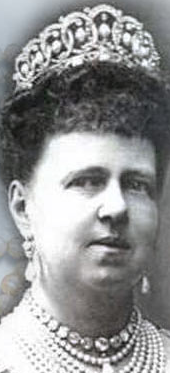 On the occasion of their Silver Wedding Anniversary in 1899. The Duchess wore on the special day, a large diamond tiara of diamond oval loops and in each loop an orient pearl drop, again like the Vladimir tiara of her sister-in-law, Grand Duchess Maria Pavlovna of Russia. 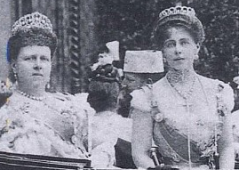 The tiara is probably of Faberge. The tiara measures 17, 9 cm. On 23 January 1874 at the Winter Palace, St. Petersburg, Russia, the Grand Duchess Marie married His Royal Highness the Duke of Edinburgh, the second son of Queen Victoria. The Duke and Duchess of Edinburgh made their public entry into London on 12 March. Apparently the marriage was not a happy one. Furthermore, Tsar Alexander II's insistence that his daughter be styled "Her Imperial Highness" and have precedence over the then Princess of Wales infuriated Queen Victoria. The Queen, Victoria, insisted that the style "Her Royal Highness" Marie Alexandrovna acquired upon marriage, should always precede the style "Her Imperial Highness," which was hers by birth. For her part, the new Duchess of Edinburgh apparently resented the fact that the Princess of Wales, who was the daughter of the King of Denmark, took precedence over her, the daughter of the Emperor of Russia. After her marriage, Marie was referred to as Her Royal Highness, Her Royal & Imperial Highness, and Her Imperial & Royal Highness. Upon her husband's ascension on 22 August 1893 to the Ducal throne, the Grand Duchess Marie Alexandrovna became Duchess of Saxe-Coburg and Gotha, in addition to being Duchess of Edinburgh. As the consort of a sovereign German duke, she technically outranked her sisters-in-law at Queen Victoria's Diamond Jubilee celebrations. | 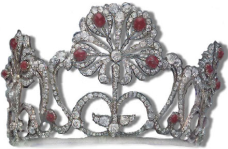 ROMANOV RUBY LOTUS FLOWER TIARA 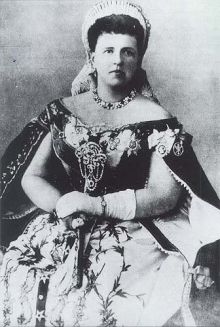 Created by Bolin and given in 1874, the year of her marriage to Prince Alfred of the United Kingdom, the parure consisted of a lotus-motif tiara, a devant de corsage and a sumptuous necklace. (the necklace and corsage are pictured above) 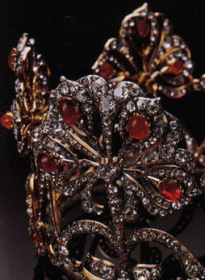 The Romanovs were believed to be superstitious about the blood-red colour of rubies, evidently Tsar Alexander II had none of these reservations. He gave this suite to his favourite child and only daughter, the Grand Duchess Marie (wife to Prince Alfred of the United Kingdom), a monumental tiara in the form of stylized lotus flowers centred with the finest Burmes rubies, made by the court jewellers, Bolin. Part of a fairy tale rubin diamond suite. The parure was inherited by their daughter Princess Alexandra of the United Kingdom and Saxe-Coburg-Gotha who got these jewels from her mother, the Grand Duchess. 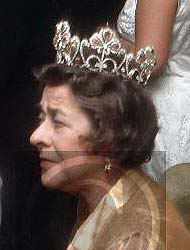 The last wearer of the set was Princess Margarita of Greece (as seen in the pictures), Princess Alexandra's daughter-in-law and subsequently sister of Prince Philip, Duke of Edinburgh. She wore the tiara to the 1962 wedding of Juan Carlos of Spain and Sofia of Greece, as well as another wedding in the 1970's (pictured). The princess died in 1981 and her jewels were auctioned off in 1989. 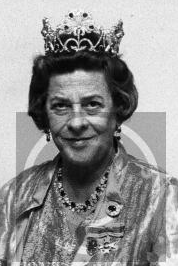 Description of the auction (tiara) in 1989: An Important Ruby and Diamond Tiara, by Bolin, Moscow, 1874, of openwork foliate scroll design set with cushion-shaped diamonds, decorated with six flowerhead cluster motifs each set with cabochon rubies in cushion-shaped diamond borders, the original faceted rubies have been sustituded at a later date, slightly imperfect. |  IMPERIAL FRINGE TIARA OF THE GRAND DUCHESS 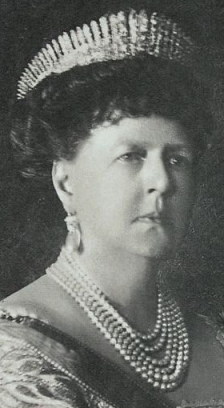 This antique diamond tiara was given by Tsar Alexander II to his daughter Marie, Duchess of Edinburgh, Duchess of Sachs-Coburg-Gotha. Modeled on the traditional court diadem, the kokoshnik, it was part of her Imperial trousseau with which every Grand Duchess was equipped. It was part of her tremendous and important dowry. 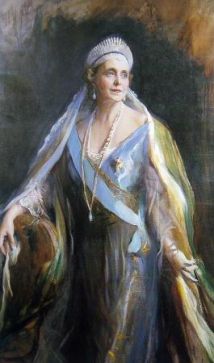 Marie Alexandrovna lent the tiara to her daughter, Marie of Romania. She was painted wearing the heirloom as shown above. 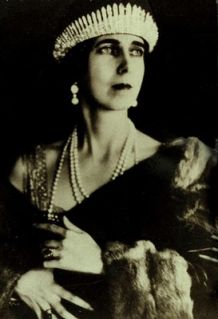 The tiara was later given to Baby Bee (Beatrice) the younger daughter of the Grand Duchess. After her marriage with the Infante of Spain, the Duke of Galleria, she lived with him in Spain and wore the tiara at the coronation of her sister at Bucharest. 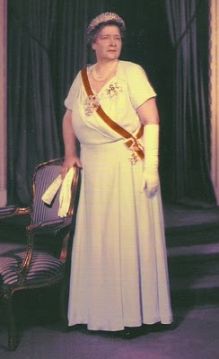 She sold the fringe tiara to her niece, Queen Marie of Yugoslavia, in order to buy a house and to build a hospital and outpatient clinic during the Spanish civil war. The tiara was sold for £10 800 on 21 July 1960 at Sotheby's London (to the dealer Levy-Cohen), as part of a consignment of jewels which had been in the possession of Queen Marie of Yugoslavia which included an important pair of earring and an eagle corsage ornament. |
SAPPHIRE TIARA OF QUEEN MARIE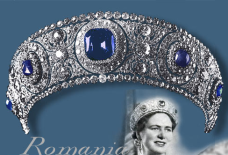 The famous sapphire and diamond tiara was commissioned from Cartier in 1909 by the Grand Duchess Vladimir, using family Sapphires which were set into a Cartier diamond tiara. The central sapphire weighed 137.20 carats and was originally mounted as a brooch. 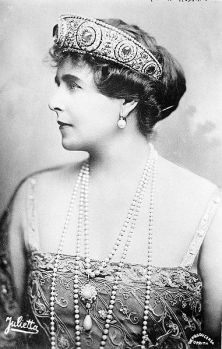 The cushion shaped sapphire in the center, was flanked by six cabochon sapphires weighing 102.16 carats on circular-cut diamond mount, from the possession of Empress Alexandra Feodorovna wife of Nikolas I. At the outbreak of the Russian Revolution of 1917, which saw the end of the Tsarist autocracy, the Grand Duchess decided to sell the tiara to pay for her passage out of Russia. It was Queen Marie of Romania whom the Duchess sold the tiara to. 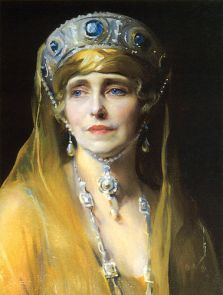 Princess Ileana's mother, Queen Marie wore it at her coronation in 1922. The tiara was then passed on to her daughter Princess Ileana who wrote about the history of the piece in one of her books. 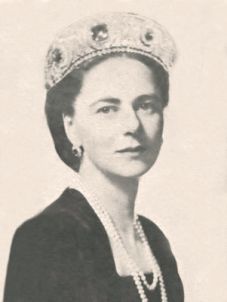 "And so the tiara and I both entered the United States twice, and together: once in 1926, when I was one of a royal party receiving an official and impressive welcome in New York City, and when the diadem was suitably packed and guarded; and once in 1950, when I flew from Argentina to Miami—hoping to avoid any public recognition—with the tiara wrapped in my nightgown! Perhaps this is not your idea of how a princess should care for her jewels? It was certainly a surprise to the customs officer! To the tiara, however, it was only one more in a long series of adventures. A few of these I know about: for example, that it was smuggled out of Russia in 1918 during the revolution there. My mother had given it to me when I was married in 1931. I lent it to her to wear at the Jubilee of King George V of England, and she left it in her bank in London because of unsettled conditions at home. After her death I had no small trouble in claiming it, but I got it away from England just before World War II actually began." - I Live Again - by Ileana, Princess of Romania CHAPTER 2/3 The diadem was eventually sold in the United States c. 1948 back to Cartier so that the Princess would be able to support her children. | MASSIN TIARA of ELIZABETH OF WIED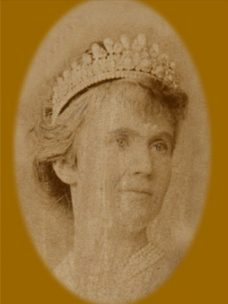 Lightness and transparency characterize the work of the celebrated French jeweler Oscar Massin, in the last quarter of the 19th century was the first century goldsmith's, who could produce against the use of platinum, relatively easy versions. This earned him many awards and patents. This piece also shows the delicate manuscript Massine. The focus this time in a rich beading, and typical of Massin, he has again created an edge of 16 free-floating diamonds, with 17 upright, and in the course has managed to arrang large-Orient pearldrops. A band of diamonds and a further series of uniformly white pearls form the bottom. Elizabeth of Romania (Elizabeth of Weid) received withthe occasion of her arrival inthe country (December 1869) this beautiful pearl and diamond tiara from the Romanian Aristocratic Ladies Association. In the later years, Carmen Sylva seldom wore any tiaras, she preferred to live a life as a writer of poems, plays, novels, short stories, essays, and collections of aphorisms. 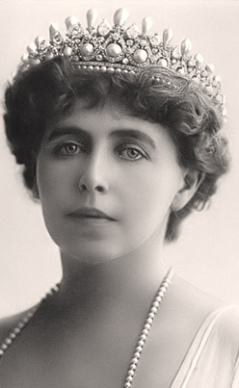 This tiara was inherited by Marie of Romania. It was unfortunately lost together with the Romanian treasury in Moscow in 1917-1918 during the Bolshevik takeover. - Diana Mandache, Royal Romania Press Blog Later the tiara went to her daughter, Queen Elisabeth of Greece who wore it at the coronation of her parents as King and Queen of Romania in 1922. 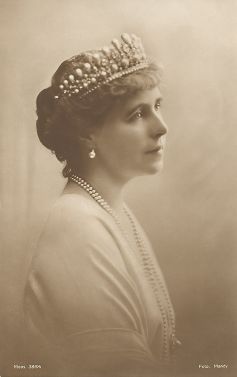 QUEEN MARIE: Queen Marie, was born the 29th of October 1875, as Princess Marie of Edinburgh, the United Kingdom at Eastwell Park in England, the eldest daughter and second child of Prince Alfred of the United Kingdom and Ireland, Duke of Edinburgh and of the Grand Duchess Maria Alexandrovna of Russia. She married Prince Ferdinand Victor Albert Meinrad of Hohenzollern-Sigmaringen, Crown Prince Ferdinand of Romania on January 10, 1893 at Schloss Sigmaringen, the residence of Prince Leopold of Hohenzollern, father of the bridegroom. | WEDDING PRESENTS OF PRINCESS MARIE OF EDINBURGH: THE DIAMOND AND TURQUOISE TIARA 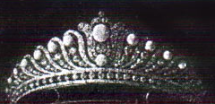 On the occasion of her wedding to Crown Prince Ferdinand of Romania, later Ferdinand I of Romania, the Princess Marie of Edinburgh and the United Kingdom received a necklace en-jewelled with clusters of fine turquoise surrounded by diamonds and an open-work tiara mounted with turquoise and diamonds and earrings to match from her father, the Duke of Edinburgh. This beautiful suite was designed and executed by Carrington Regent Street London. 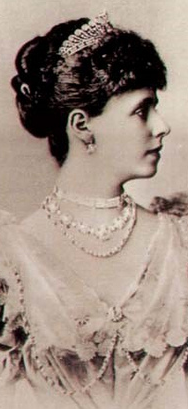 In her notes Queen Marie wrote about her trousseau and the jewels: "Mama gave me a wonderful trousseau, a real princess' trousseau in keeping with that time of prosperity and abundance. There were also innumerable wedding presents, some magnificent, some beautiful, some humble and touching; this was all very exciting and pleasurable. I took a quite childish pleasure in my new dresses and beautiful jewels. Mama had been extraordinarily prodigal, giving many of her own magnificent Russian gems. These have all now been annexed by the Bolsheviks. It was difficult to realize that they were all mine. It was rather the same feeling that we had had in those far-off days when playing with old Hutchins, when I liked to imagine I was the Queen of Spain. 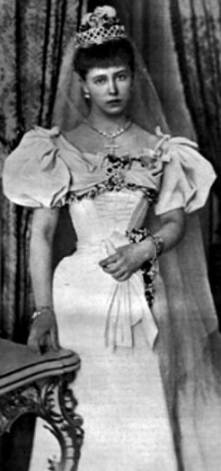 And then the morning came when I awoke to the sound of bells—festive bells—bells for my own wedding. We had to submit to a threefold marriage, civil, Catholic and Protestant. The ceremonies took place in the morning and ended with a huge wedding breakfast. I remember it all as though it were a dream—a very far-off dream in which I played a dream part. My wedding dress was of lusterless, heavy white silk, with puffed sleeves, of course, and bell skirt spreading out into a train. I had a dislike of lace veils, so in spite of all the old family lace I wore tulle, kept in place by a diamond tiara inside which a small wreath of orange blossoms lay curled as in a nest. I was a thin, flat little maiden with very fair hair, frizzled Queen Alexandra-wise on the forehead; my features were immature, my eyes blue; there was not much dignity about me. I looked as absurdly young as I was, and I felt as if I were playing at being grown up." |
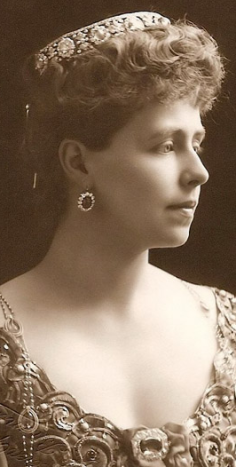 This circlet-tiara was worn many times, but perhaps the most important event Queen Marie of Romania wore it to was in 1885, when she was 20, at the coronation ceremony of Russia's tsar, her cousin, Nicolas II in Moscow. | BLACK DIAMOND KOKOSHNIK OF QUEEN MARIE OF ROMANIA 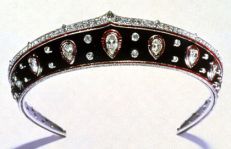 A kokoshnik-shaped gemset platinum-mounted blackened steel tiara, the metal band bordered with calibré-cut rubies, with a band of old-mine diamonds above and rose-cut diamonds below, set with thirteen pear-shaped diamonds within calibré-cut ruby-set frames alternating with pairs of collet-set circular-cut diamonds - workshop: Picq, stamped HP, Paris 1914, height 1 5/8 inches (4.1 cm), diam. 7 1/16 inches (18 cm) 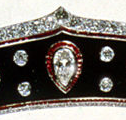 Provenance: Queen Marie of Romania Art of Cartier Collection, Geneva | 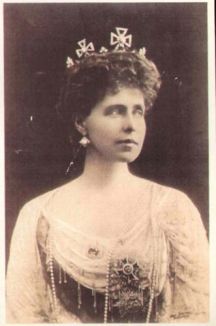 This photo of Queen Marie was taken before or during the early stages of World War I (she turned 40 in 1915). Not much is known about it as the tiara has been lost. The Romanian Royal Family entrusted their most important jewels to the care of the Russians during the war, only for the Bolsheviks to seize them when they came to power. As discussed before, none were recovered. |
QUEEN MARIE OF ROMANIA'S VARIOUS TIARAS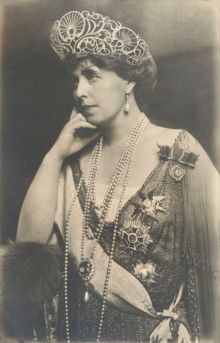 Princess Marie of Edinburgh, Princess of the United Kingdom and granddaughter of Queen Victoria. Pictured above is thought to be one of her theatrical tiaras which was not considered valuable. 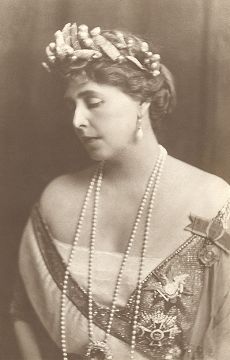 Laurel wreath tiaras were popular and still are today. 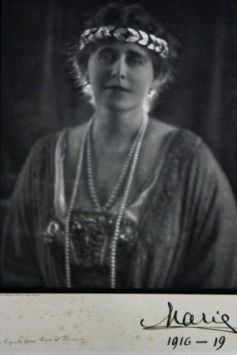 Many of her other personal effects can be seen at the Maryhill Museum, formerly the home of Samuel Hill, an American railroad businessman with whom Queen Marie corresponded much of her life. The famous museum, which lies in Washington State (U.S.A.) on the north side of the Columbia River, displays much of Queen Marie's regalia, furniture, and other possessions, including her crown. |  DIAMOND LOOP TIARA DIAMOND LOOP TIARA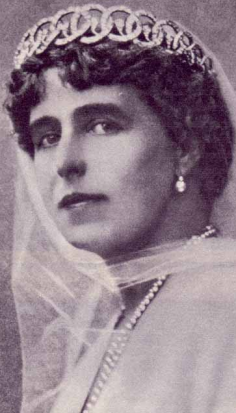 This interlocking circle tiara was quite popular in the time of Queen Marie. One could compare this tiara to the Vladimir tiara of Duchess Marie, featured above, but it is different. 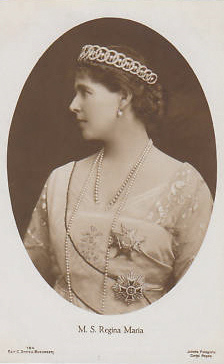 This wonderful diamond circle tiara was in the possession of Queen Marie, but when she left her jewels in the Moscow bank for safe keeping during the Revolution, the Soviets stole this tiara along with other jewels and they have not been seen since. 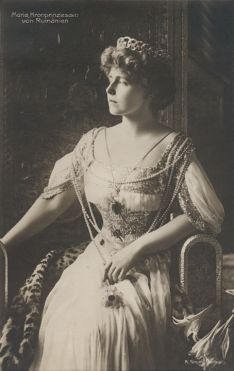 | REGINA MARIE OF ROMANIA'S PEARL & DIAMOND TIARA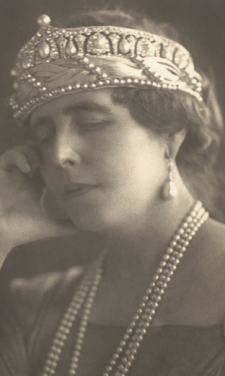 This is a pearl and diamond bandeau which Queen Marie wore in different styles. Above, she wears it over a silk and pearl head band. 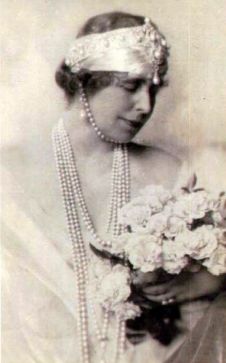 In this photo, Marie is shown wearing the tiara above a silk head band on which a pearl and diamond pin has been attached. The silk head band has a string of pearls which strings across her head to the other side, holding the piece in place. Like many of her other jewels this tiara is thought to have disappeared as it has not been seen since the Revolution. 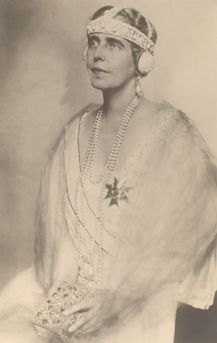 Like the greek-key tiara, this tiara was also held on the head by headbands and in this picture there are circles of pearls over her ears. |
| CONTINUATION of the emerald diadem... Elisabeth Feodorovna nee Princess Elisabeth of Hesse and by Rhine, Grand Duchess of Russia The granddaughter of Queen Victoria of Great Britain and daughter of Princess Alice. 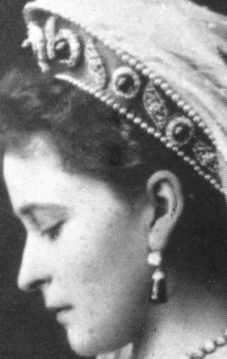 For official court receptions all female members wore a very typical Russian court costume together with the traditional sickle-shaped kokoshnik which was placed on the back of the head together with a veil. The kokoshniks matched the evening gowns with its choosen fabrics and were mostly of silk or satin. The front of the kokoshniks were decorated with various precious jewels which were sewn directly to it. The Grand Duchess has choosen to wear for this occasion her emeralds which can be detached from the tiara. The Russian court jewellers were prepared for such "changes" and developed quite early a mechanism for removing various elements from pieces of jewellery with ease. For this purpose, small screws or hinges were at the back with which those ornaments could be removed. The detached elements were simply sewn directly to the desired garment. It is easy to recognize in the old photograph such a traditional kokoshnik where seven round emerald cabochons in their rich diamond frames are fastened. In addition there are in-between some shuttle-shaped diamond elements which were lent from the imperial jewellery fund. The kokoshnik was lined by pearl ropes. 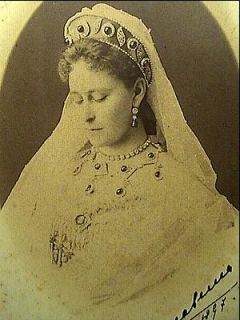 Elizabeth would later become Abbess of a nunnery after the killing of her husband. She sold off all her belongings. Nothing was spared. Dreadfully, Elizabeth would later be killed by the same party who killed the Romanov family. She was later canonized by the Russian Orthodox church. | 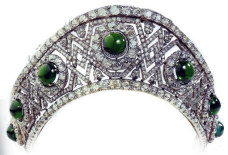 Emerald and Diamond Tiara and Sautoir of Queen Marie of Yugoslavia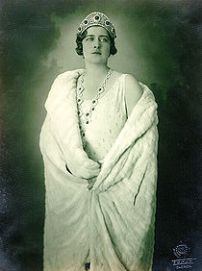 Princess Marie of Romania, Queen of Yugoslavia - daughter of Princess Marie of Edinburgh, Queen of Romania From 1908, the emerald parure of Grand Duchess Elisabeth Feodorovna (Grand Duchess Ella) was in the possession of Maria Pavlovna the younger. When she was in exile in Romania, after the Russian Revolution, the Grand Duchess sold the emerald tiara and the matching necklace to King Alexander I of Serbia (1888-1934) who purchased them as a wedding gift for his bride Princess Maria of Romania, also known as Mignon (1900-1961).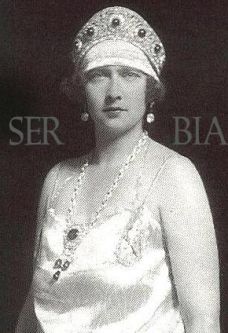 These jewels had originally belonged to Mignon’s maternal great-grandmother, Czarina Maria Alexandrovna. Queen Marie described the emeralds as “imperial stones, the like of which I hadn’t seen since Russia” as “she arranged them on her daughter for the gala banquet the night before the wedding.” Source: Pakula, Hannah. Queen of Roumania: The Life of Princess Marie, grand-daughter of Queen Victoria. London; Eland, 1989. p316 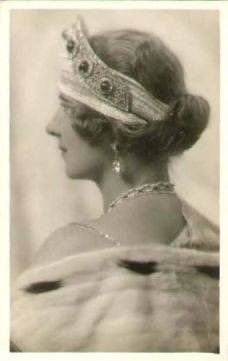 | THE KOKOSHNIK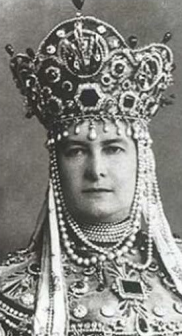 The style is taken from the Grand Duchess Vladimir who sports a Kokoshnik imperial style hat adorned with large precious stones and jewels. 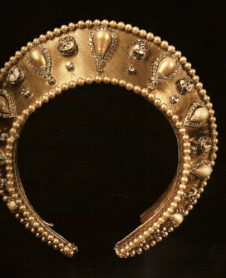 The kokoshnik is a traditional Russian head-dress worn by women and girls to accompany the sarafan. It is patterned to match the style of the sarafan and can be pointed or round. It is tied at the back of the head with long thick ribbons in a large bow. The forehead is sometimes decorated with pearls. The woman or the girl usually wears her hair in a plait. It resembles the French hood worn in Tudor England, but without the veil. 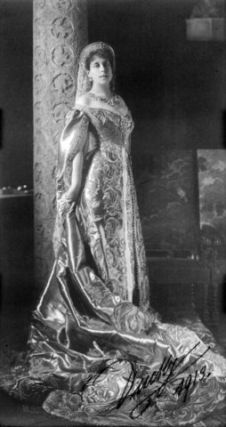 During the revival of Russian national culture in the late 19th century, these diadem-shaped tiaras became part of the official court dress for royalty and ladies-in-waiting. It was worn by peasant girls and women on special occasions until the Russian Revolution. After the Revolution, the kokoshnik was introduced into the Western fashion by Russian émigrés. Even before, it was a wedding head dress of Mary of Teck, the Queen consort of the United Kingdom. |
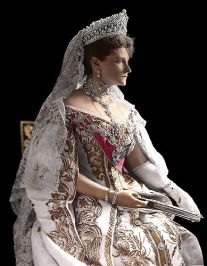 Empress Alexandra Feodorovna Romanova Empress Alexandra Feodorovna Romanova(Alix of Hesse) 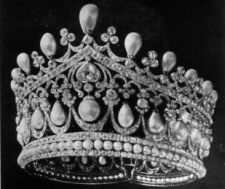 Wife of Tsar Nicholas II of Russia. Wife of Tsar Nicholas II of Russia. Granddaughter of Queen Victoria of Great Britain, and daughter of Princess Alice, Grand Duchess of Hesse. 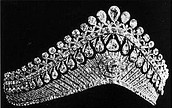 She would later be known as Saint Alexandra the Passion Bearer. 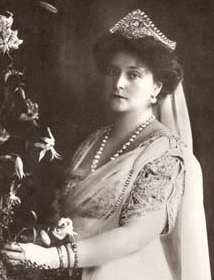 | 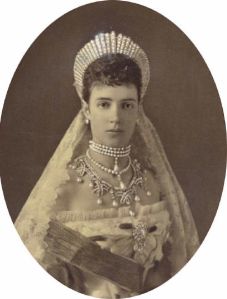 Empress Maria Feodorovna of Russia Romanova (Dagmar, Princess of Denmark) Sister of Alexandra, Queen consort of the United Kingdom. Empress Maria and her sister Alexandra were the great-great-granddaughters of Princess Louise of Great Britain and her sister Princess Mary of Great Britain. 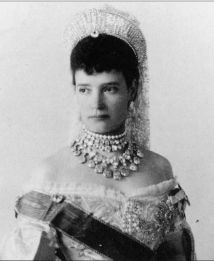 Empress Maria was of course the mother of the last Czar, Nicholas II of Russia. More examples of the Russian kokoshnik: 1) Grand Duchess Maria Georgievna nee Princess Maria of Greece and Denmark 2) Grand Duchess Elizabeth Feodorovna Romanov 3) Grand Duchess Maria Pavlovna nee Marie of Mecklenburg-Schwerin  | 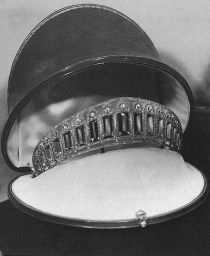 The Empress Alexandra of Russia had a soft spot for bright, clear color and the gem, which fits so well with the fashion of the last century and with the pastel colors of Enameled Faberge accessories left combined. At the same time, she was empress of taste-forming and therefore important for the export of Russian gems, including the Aquamarine. Do I need a gift, it was announced at Faberge, which the Tsarina preferred taste, then they got to countless occasions, large and small gifts, which she likes to collect and belonged mainly jewelry, which belonged to her personally. For the large Parure were even gifts that had traditionally but once the crown jewels are fed, where they were well managed and preserved. So they wanted to create a piece of jewelry, she was forced to "borrow" their own jewelry from the vault and immediately turn to give back. Otherwise, their personal jewelry, in a secret safe, kept in the bedroom of the monarch, they had easy access to. It is said that Alexander had imperceptibly built up in their private safe, one of the largest private collections of jewelry. For herself she bought nothing, but could not give all jewelry, especially the Tsar who loved his wife to bless with jewelry, he liked when she was Russian traditionally decorated with jewels. The Empress came from a ruling, but not very rich, House of Hesse and without substantial personal assets, she wanted for herself and her daughters a cushion that they could sell at any time. The tiara was bought by Wartski in 1920 and was made of platinum with diamonds and aquamarines worked as a tiara in 1900. |
Sources
Some tiaras already have the source in the box, for others:
Alexander Palace Time Machine Forums
<a class="external" href="http://www.christies.com/" rel="nofollow" target="_blank">Christie's of London</a> ONLINE
CNN
<a class="external" href="http://books.google.com/books?id=xnKpjh1gkqgC&dq=nizam+of+hyderabad+tiara&source=gbs_navlinks_s" rel="nofollow" target="_blank">Cartier</a>By Hans Nadelhoffer
Forbes.com
Internet Stones website
Mandy's British Royalty Blog: British Jewels
The Official Royal Collection website
"The Royal Jewels" -REVISED- by Suzy Menkes
"The Queen's Jewels" by Leslie Field
The Royal Magazine website
The Royal Forums
Yahoo! News
Wikipedia
Some tiaras already have the source in the box, for others:
Alexander Palace Time Machine Forums
<a class="external" href="http://www.christies.com/" rel="nofollow" target="_blank">Christie's of London</a> ONLINE
CNN
<a class="external" href="http://books.google.com/books?id=xnKpjh1gkqgC&dq=nizam+of+hyderabad+tiara&source=gbs_navlinks_s" rel="nofollow" target="_blank">Cartier</a>By Hans Nadelhoffer
Forbes.com
Internet Stones website
Mandy's British Royalty Blog: British Jewels
The Official Royal Collection website
"The Royal Jewels" -REVISED- by Suzy Menkes
"The Queen's Jewels" by Leslie Field
The Royal Magazine website
The Royal Forums
Yahoo! News
Wikipedia

